Remediation Report on Old Millers Point Gasworks
VerifiedAdded on 2022/11/13
|9
|1232
|318
Presentation
AI Summary
This report discusses the remediation process of Old Millers Point Gasworks, its impact on the environment and tourism in Bangaroo. It also covers the methodology, expected results, and planning of the remediation process.
Contribute Materials
Your contribution can guide someone’s learning journey. Share your
documents today.
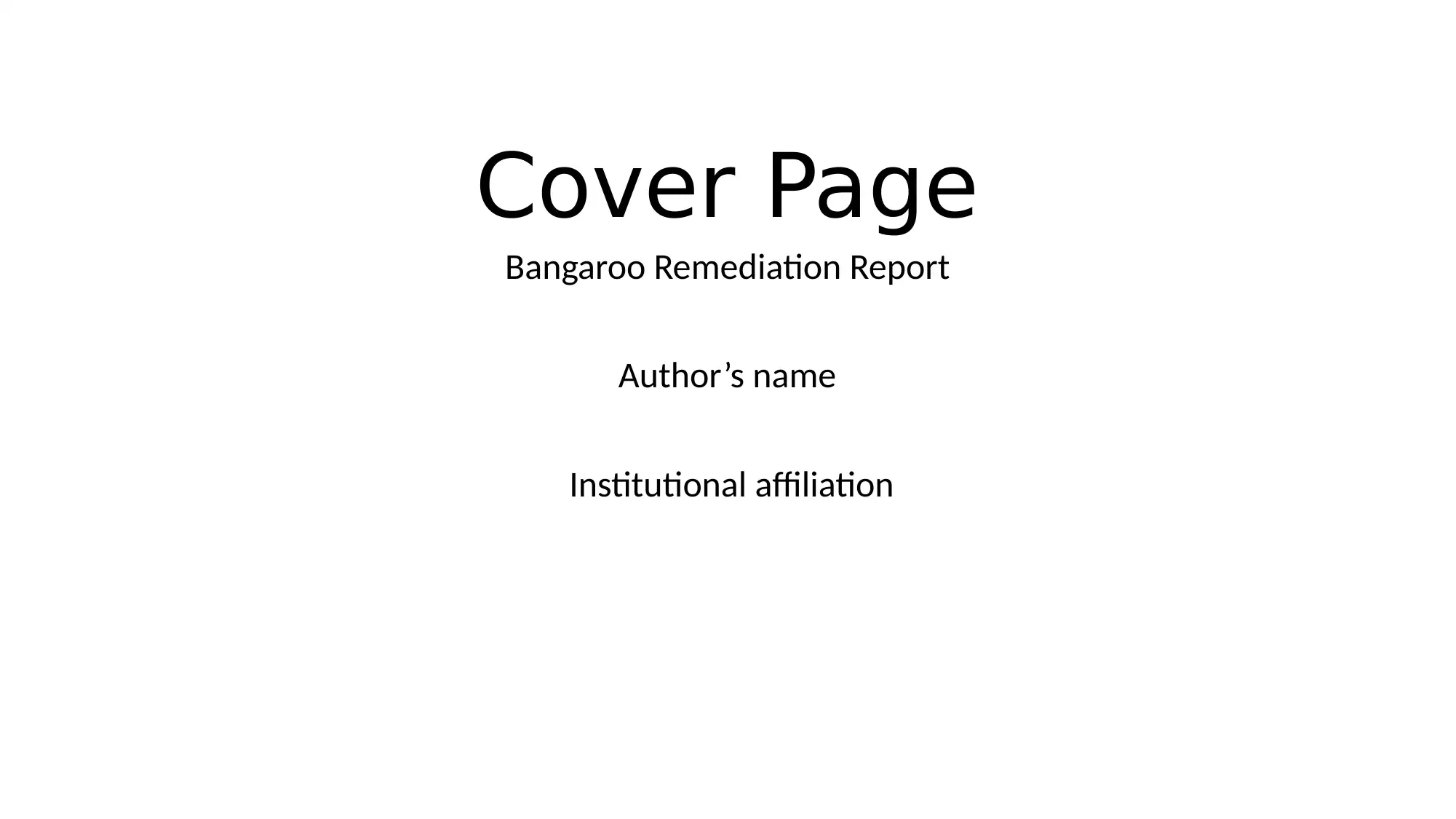
Cover Page
Bangaroo Remediation Report
Author’s name
Institutional affiliation
Bangaroo Remediation Report
Author’s name
Institutional affiliation
Secure Best Marks with AI Grader
Need help grading? Try our AI Grader for instant feedback on your assignments.
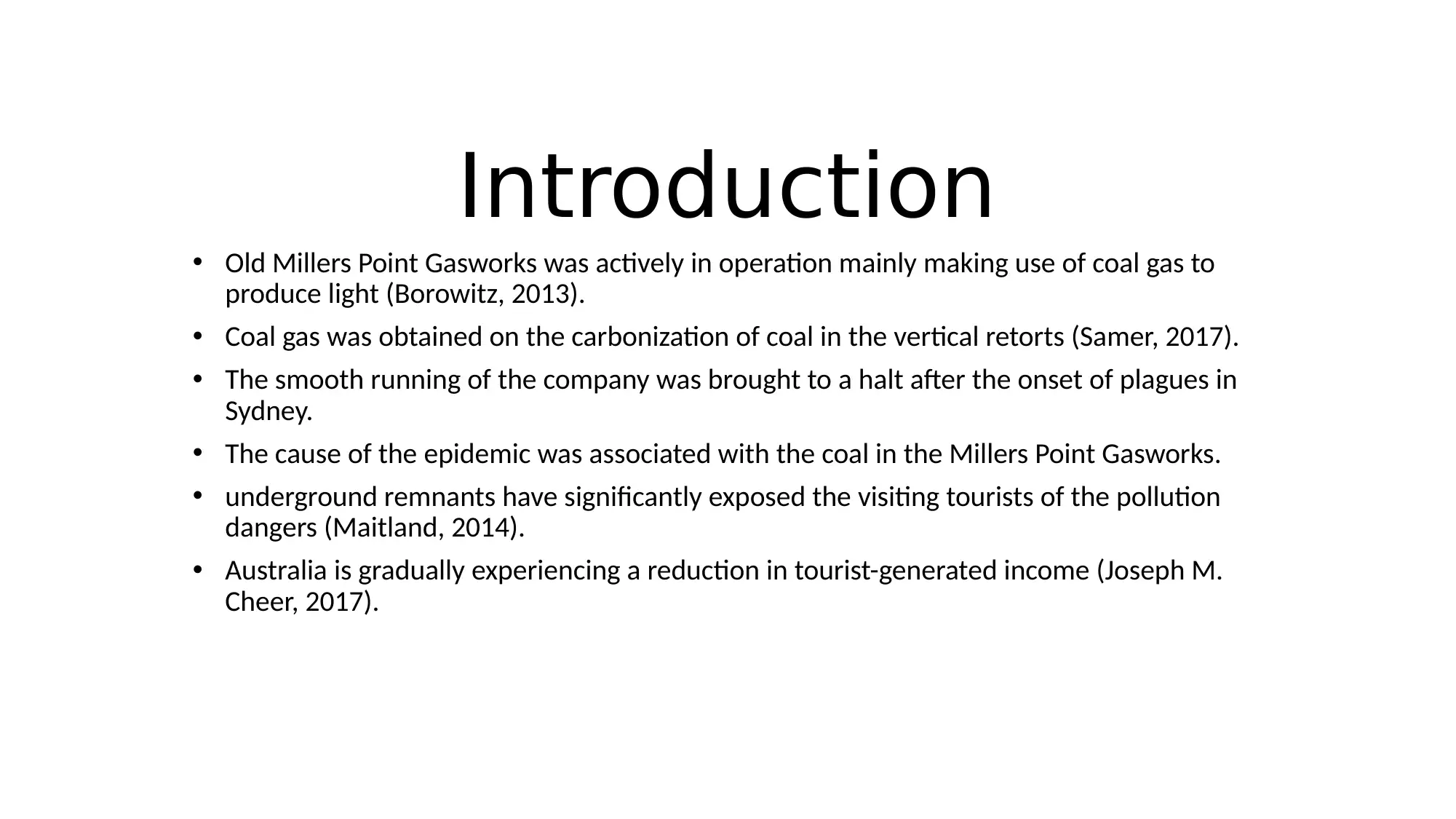
Introduction
• Old Millers Point Gasworks was actively in operation mainly making use of coal gas to
produce light (Borowitz, 2013).
• Coal gas was obtained on the carbonization of coal in the vertical retorts (Samer, 2017).
• The smooth running of the company was brought to a halt after the onset of plagues in
Sydney.
• The cause of the epidemic was associated with the coal in the Millers Point Gasworks.
• underground remnants have significantly exposed the visiting tourists of the pollution
dangers (Maitland, 2014).
• Australia is gradually experiencing a reduction in tourist-generated income (Joseph M.
Cheer, 2017).
• Old Millers Point Gasworks was actively in operation mainly making use of coal gas to
produce light (Borowitz, 2013).
• Coal gas was obtained on the carbonization of coal in the vertical retorts (Samer, 2017).
• The smooth running of the company was brought to a halt after the onset of plagues in
Sydney.
• The cause of the epidemic was associated with the coal in the Millers Point Gasworks.
• underground remnants have significantly exposed the visiting tourists of the pollution
dangers (Maitland, 2014).
• Australia is gradually experiencing a reduction in tourist-generated income (Joseph M.
Cheer, 2017).
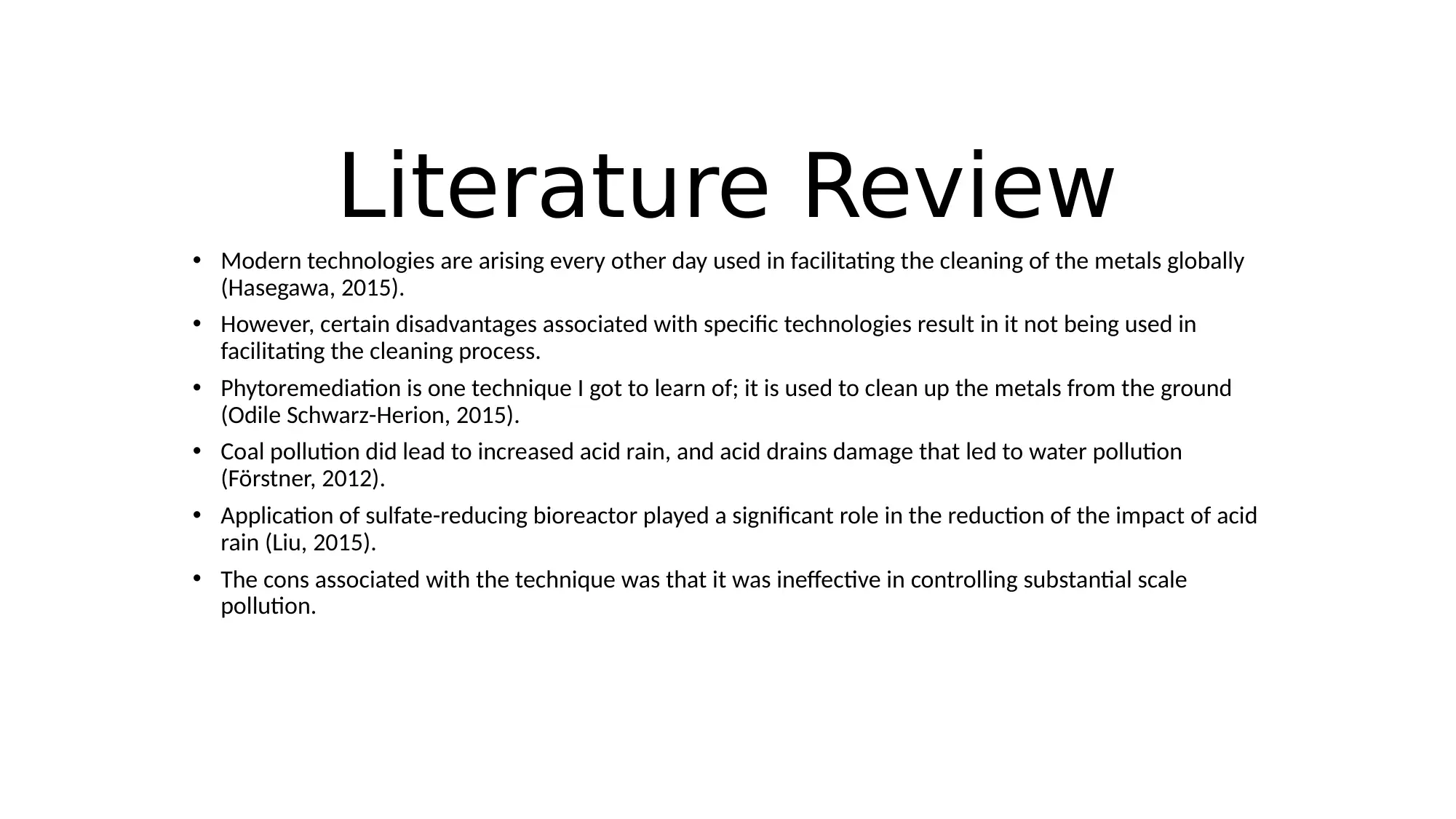
Literature Review
• Modern technologies are arising every other day used in facilitating the cleaning of the metals globally
(Hasegawa, 2015).
• However, certain disadvantages associated with specific technologies result in it not being used in
facilitating the cleaning process.
• Phytoremediation is one technique I got to learn of; it is used to clean up the metals from the ground
(Odile Schwarz-Herion, 2015).
• Coal pollution did lead to increased acid rain, and acid drains damage that led to water pollution
(Förstner, 2012).
• Application of sulfate-reducing bioreactor played a significant role in the reduction of the impact of acid
rain (Liu, 2015).
• The cons associated with the technique was that it was ineffective in controlling substantial scale
pollution.
• Modern technologies are arising every other day used in facilitating the cleaning of the metals globally
(Hasegawa, 2015).
• However, certain disadvantages associated with specific technologies result in it not being used in
facilitating the cleaning process.
• Phytoremediation is one technique I got to learn of; it is used to clean up the metals from the ground
(Odile Schwarz-Herion, 2015).
• Coal pollution did lead to increased acid rain, and acid drains damage that led to water pollution
(Förstner, 2012).
• Application of sulfate-reducing bioreactor played a significant role in the reduction of the impact of acid
rain (Liu, 2015).
• The cons associated with the technique was that it was ineffective in controlling substantial scale
pollution.
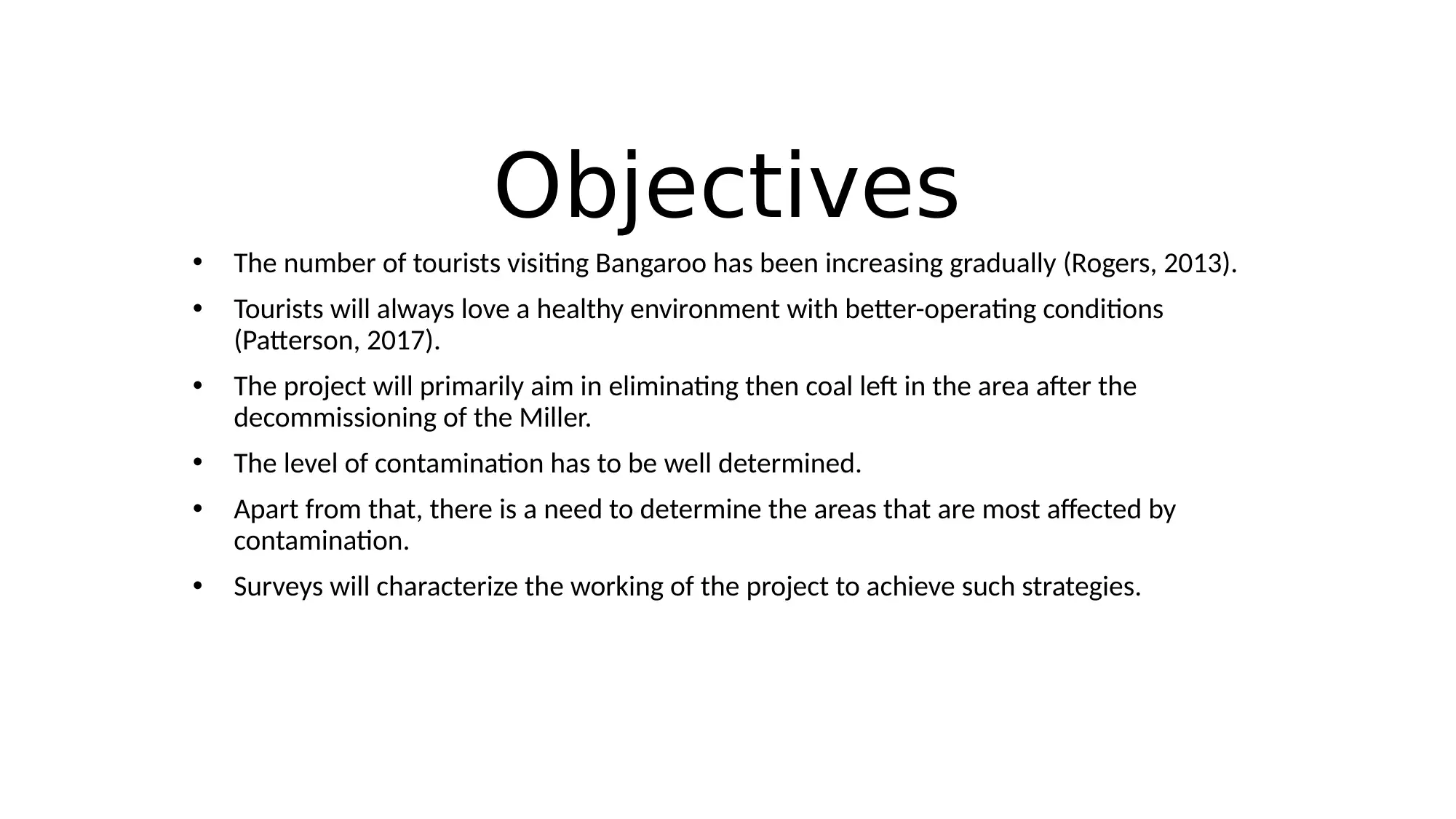
Objectives
• The number of tourists visiting Bangaroo has been increasing gradually (Rogers, 2013).
• Tourists will always love a healthy environment with better-operating conditions
(Patterson, 2017).
• The project will primarily aim in eliminating then coal left in the area after the
decommissioning of the Miller.
• The level of contamination has to be well determined.
• Apart from that, there is a need to determine the areas that are most affected by
contamination.
• Surveys will characterize the working of the project to achieve such strategies.
• The number of tourists visiting Bangaroo has been increasing gradually (Rogers, 2013).
• Tourists will always love a healthy environment with better-operating conditions
(Patterson, 2017).
• The project will primarily aim in eliminating then coal left in the area after the
decommissioning of the Miller.
• The level of contamination has to be well determined.
• Apart from that, there is a need to determine the areas that are most affected by
contamination.
• Surveys will characterize the working of the project to achieve such strategies.
Secure Best Marks with AI Grader
Need help grading? Try our AI Grader for instant feedback on your assignments.
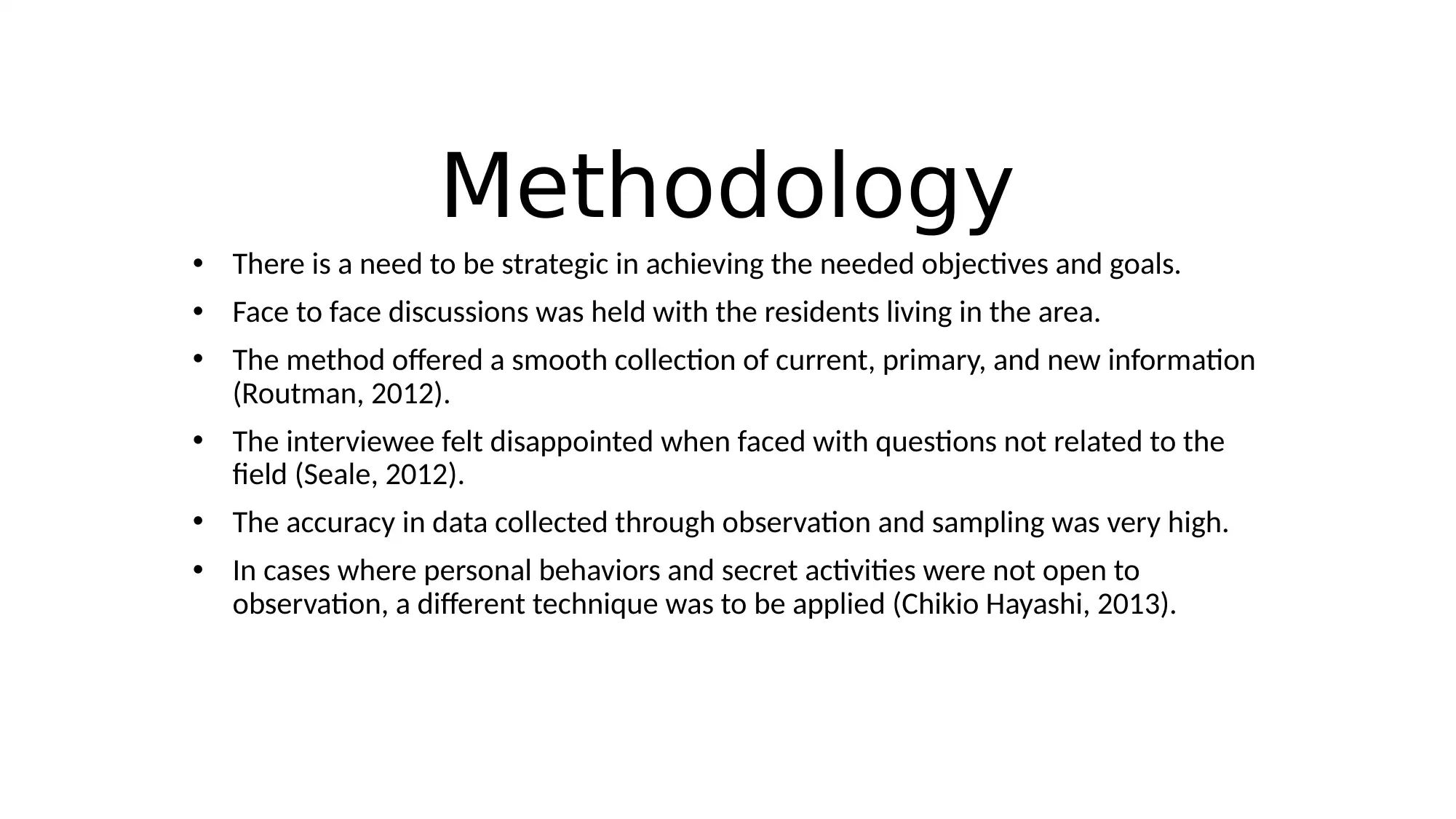
Methodology
• There is a need to be strategic in achieving the needed objectives and goals.
• Face to face discussions was held with the residents living in the area.
• The method offered a smooth collection of current, primary, and new information
(Routman, 2012).
• The interviewee felt disappointed when faced with questions not related to the
field (Seale, 2012).
• The accuracy in data collected through observation and sampling was very high.
• In cases where personal behaviors and secret activities were not open to
observation, a different technique was to be applied (Chikio Hayashi, 2013).
• There is a need to be strategic in achieving the needed objectives and goals.
• Face to face discussions was held with the residents living in the area.
• The method offered a smooth collection of current, primary, and new information
(Routman, 2012).
• The interviewee felt disappointed when faced with questions not related to the
field (Seale, 2012).
• The accuracy in data collected through observation and sampling was very high.
• In cases where personal behaviors and secret activities were not open to
observation, a different technique was to be applied (Chikio Hayashi, 2013).
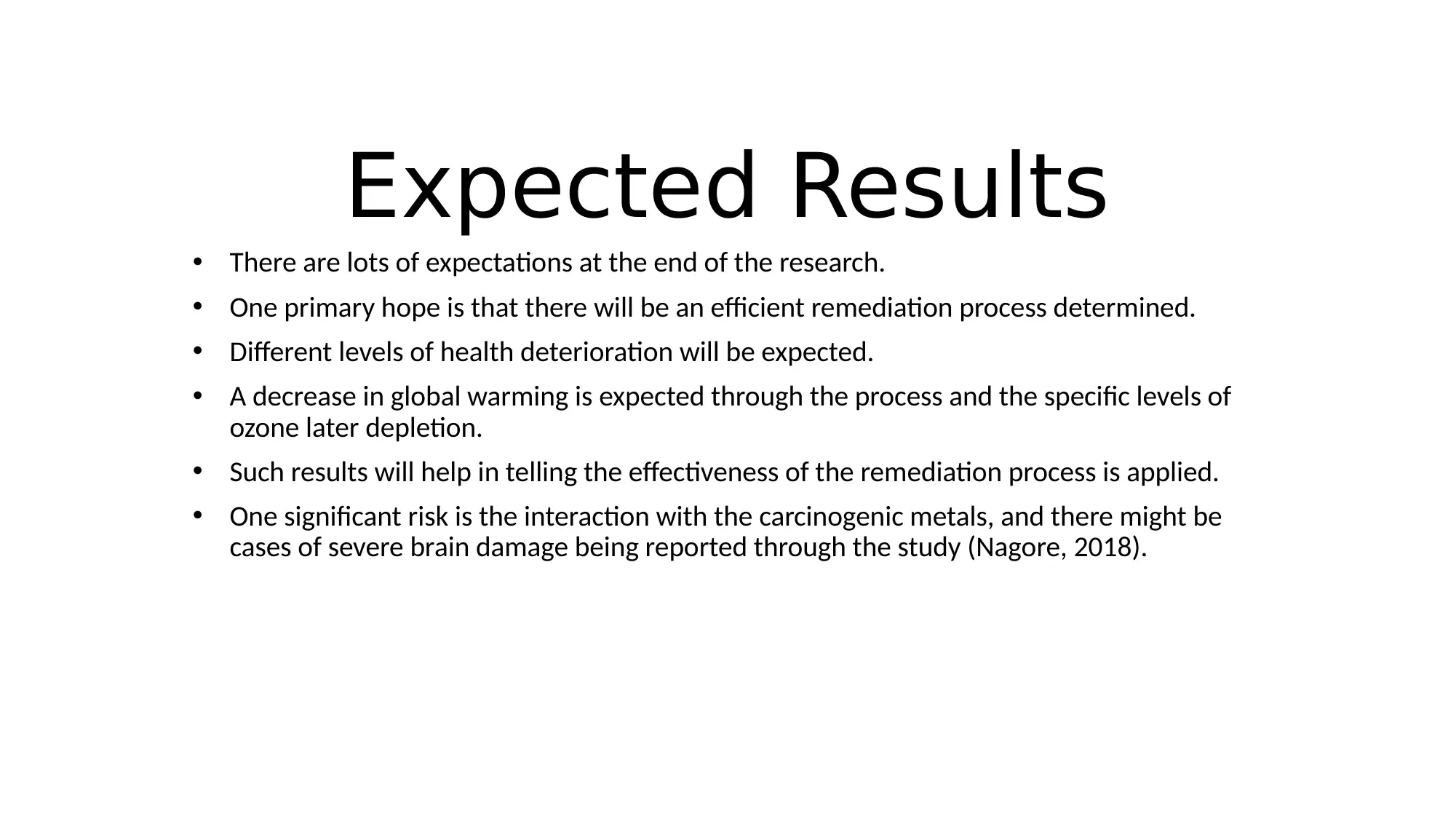
Expected Results
• There are lots of expectations at the end of the research.
• One primary hope is that there will be an efficient remediation process determined.
• Different levels of health deterioration will be expected.
• A decrease in global warming is expected through the process and the specific levels of
ozone later depletion.
• Such results will help in telling the effectiveness of the remediation process is applied.
• One significant risk is the interaction with the carcinogenic metals, and there might be
cases of severe brain damage being reported through the study (Nagore, 2018).
• There are lots of expectations at the end of the research.
• One primary hope is that there will be an efficient remediation process determined.
• Different levels of health deterioration will be expected.
• A decrease in global warming is expected through the process and the specific levels of
ozone later depletion.
• Such results will help in telling the effectiveness of the remediation process is applied.
• One significant risk is the interaction with the carcinogenic metals, and there might be
cases of severe brain damage being reported through the study (Nagore, 2018).
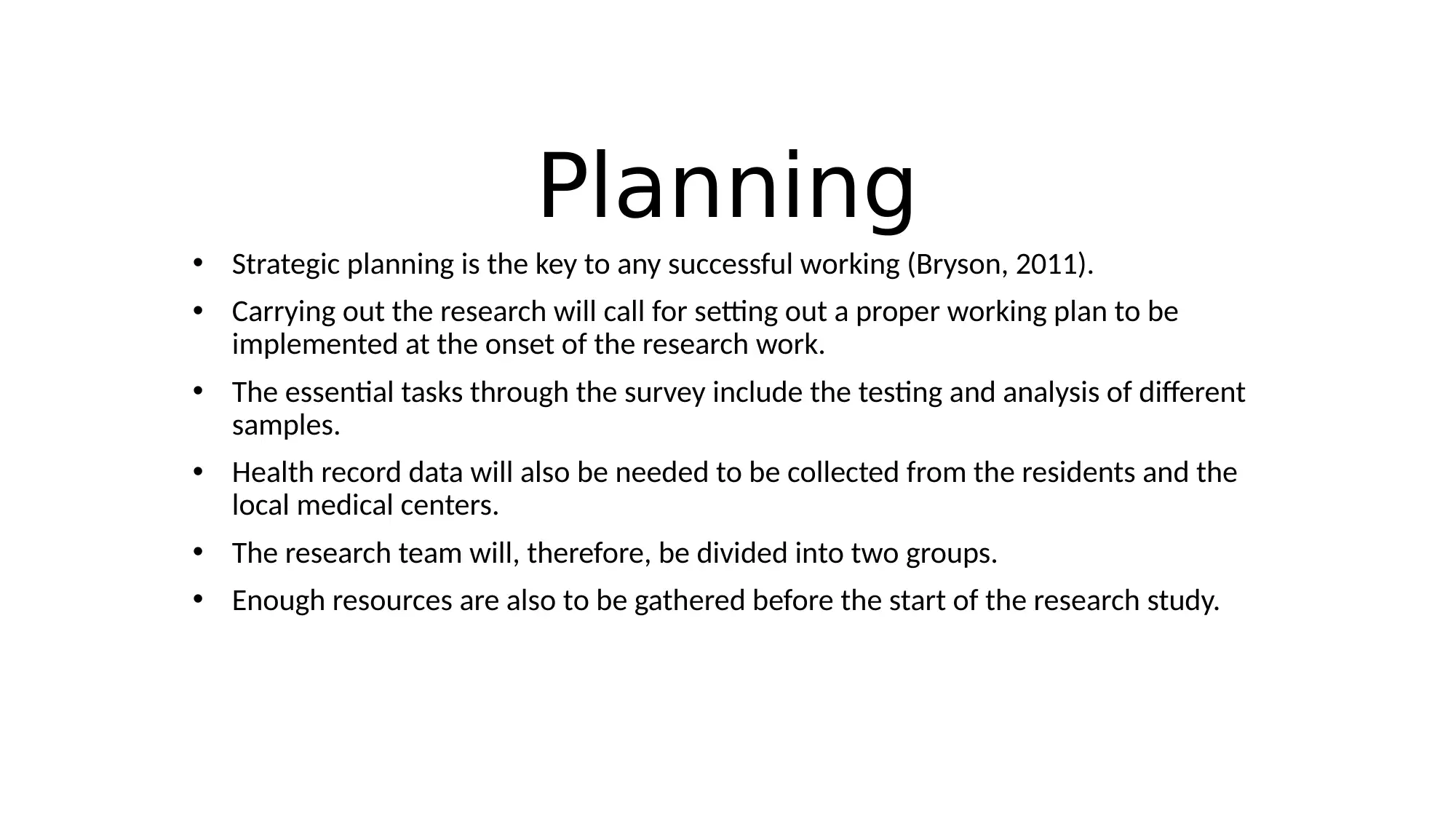
Planning
• Strategic planning is the key to any successful working (Bryson, 2011).
• Carrying out the research will call for setting out a proper working plan to be
implemented at the onset of the research work.
• The essential tasks through the survey include the testing and analysis of different
samples.
• Health record data will also be needed to be collected from the residents and the
local medical centers.
• The research team will, therefore, be divided into two groups.
• Enough resources are also to be gathered before the start of the research study.
• Strategic planning is the key to any successful working (Bryson, 2011).
• Carrying out the research will call for setting out a proper working plan to be
implemented at the onset of the research work.
• The essential tasks through the survey include the testing and analysis of different
samples.
• Health record data will also be needed to be collected from the residents and the
local medical centers.
• The research team will, therefore, be divided into two groups.
• Enough resources are also to be gathered before the start of the research study.
Paraphrase This Document
Need a fresh take? Get an instant paraphrase of this document with our AI Paraphraser
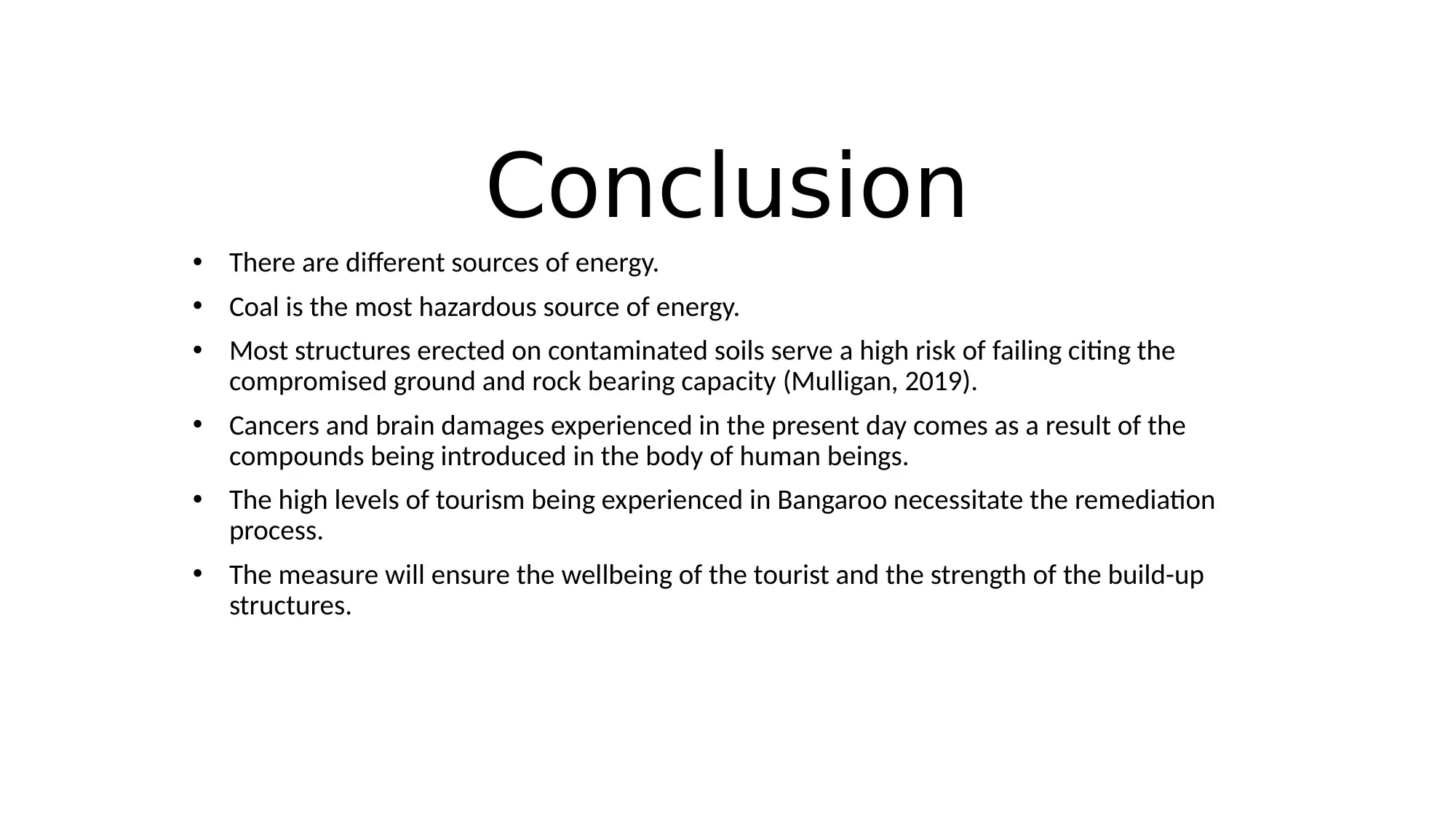
Conclusion
• There are different sources of energy.
• Coal is the most hazardous source of energy.
• Most structures erected on contaminated soils serve a high risk of failing citing the
compromised ground and rock bearing capacity (Mulligan, 2019).
• Cancers and brain damages experienced in the present day comes as a result of the
compounds being introduced in the body of human beings.
• The high levels of tourism being experienced in Bangaroo necessitate the remediation
process.
• The measure will ensure the wellbeing of the tourist and the strength of the build-up
structures.
• There are different sources of energy.
• Coal is the most hazardous source of energy.
• Most structures erected on contaminated soils serve a high risk of failing citing the
compromised ground and rock bearing capacity (Mulligan, 2019).
• Cancers and brain damages experienced in the present day comes as a result of the
compounds being introduced in the body of human beings.
• The high levels of tourism being experienced in Bangaroo necessitate the remediation
process.
• The measure will ensure the wellbeing of the tourist and the strength of the build-up
structures.
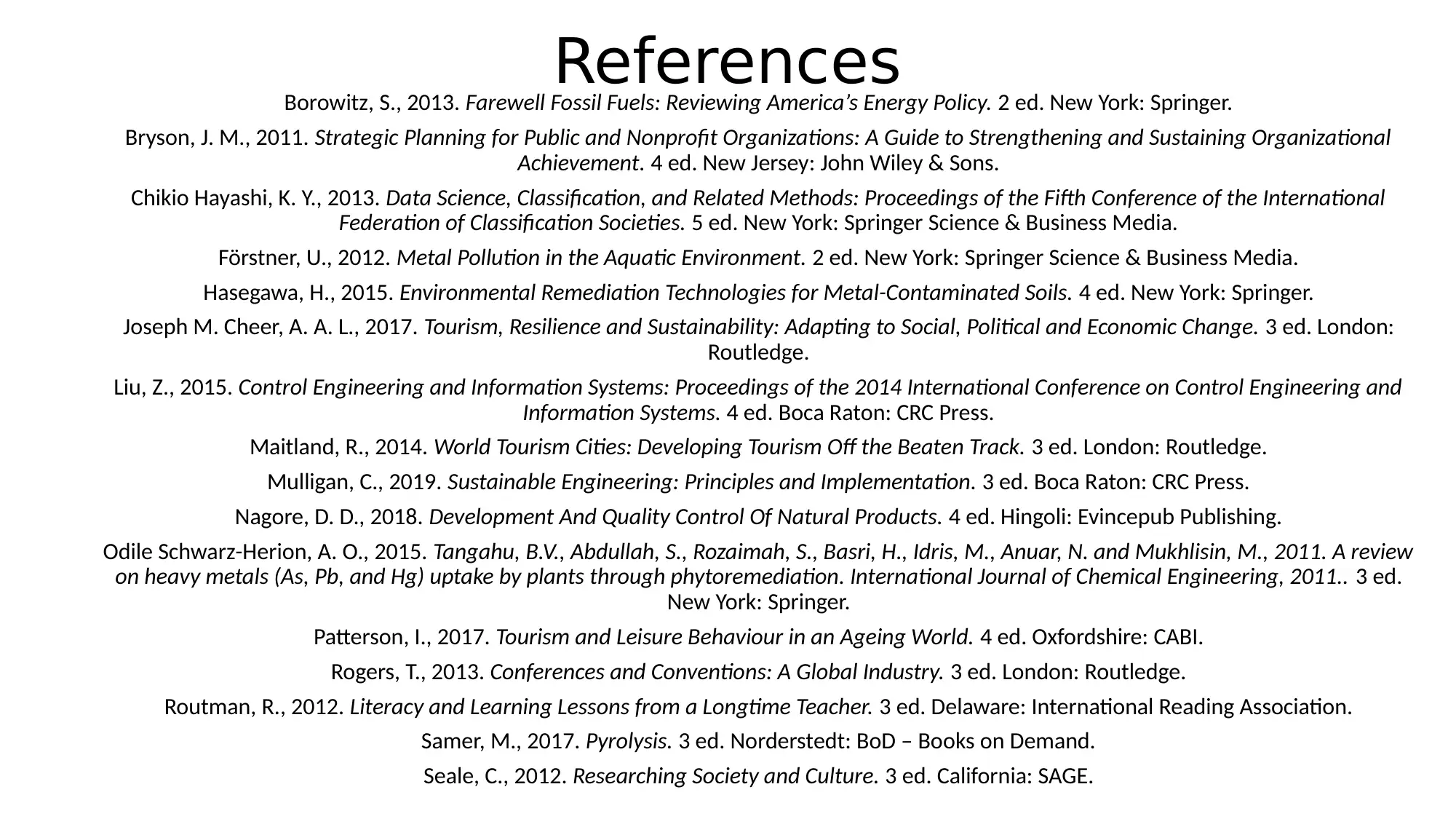
ReferencesBorowitz, S., 2013. Farewell Fossil Fuels: Reviewing America’s Energy Policy. 2 ed. New York: Springer.
Bryson, J. M., 2011. Strategic Planning for Public and Nonprofit Organizations: A Guide to Strengthening and Sustaining Organizational
Achievement. 4 ed. New Jersey: John Wiley & Sons.
Chikio Hayashi, K. Y., 2013. Data Science, Classification, and Related Methods: Proceedings of the Fifth Conference of the International
Federation of Classification Societies. 5 ed. New York: Springer Science & Business Media.
Förstner, U., 2012. Metal Pollution in the Aquatic Environment. 2 ed. New York: Springer Science & Business Media.
Hasegawa, H., 2015. Environmental Remediation Technologies for Metal-Contaminated Soils. 4 ed. New York: Springer.
Joseph M. Cheer, A. A. L., 2017. Tourism, Resilience and Sustainability: Adapting to Social, Political and Economic Change. 3 ed. London:
Routledge.
Liu, Z., 2015. Control Engineering and Information Systems: Proceedings of the 2014 International Conference on Control Engineering and
Information Systems. 4 ed. Boca Raton: CRC Press.
Maitland, R., 2014. World Tourism Cities: Developing Tourism Off the Beaten Track. 3 ed. London: Routledge.
Mulligan, C., 2019. Sustainable Engineering: Principles and Implementation. 3 ed. Boca Raton: CRC Press.
Nagore, D. D., 2018. Development And Quality Control Of Natural Products. 4 ed. Hingoli: Evincepub Publishing.
Odile Schwarz-Herion, A. O., 2015. Tangahu, B.V., Abdullah, S., Rozaimah, S., Basri, H., Idris, M., Anuar, N. and Mukhlisin, M., 2011. A review
on heavy metals (As, Pb, and Hg) uptake by plants through phytoremediation. International Journal of Chemical Engineering, 2011.. 3 ed.
New York: Springer.
Patterson, I., 2017. Tourism and Leisure Behaviour in an Ageing World. 4 ed. Oxfordshire: CABI.
Rogers, T., 2013. Conferences and Conventions: A Global Industry. 3 ed. London: Routledge.
Routman, R., 2012. Literacy and Learning Lessons from a Longtime Teacher. 3 ed. Delaware: International Reading Association.
Samer, M., 2017. Pyrolysis. 3 ed. Norderstedt: BoD – Books on Demand.
Seale, C., 2012. Researching Society and Culture. 3 ed. California: SAGE.
Bryson, J. M., 2011. Strategic Planning for Public and Nonprofit Organizations: A Guide to Strengthening and Sustaining Organizational
Achievement. 4 ed. New Jersey: John Wiley & Sons.
Chikio Hayashi, K. Y., 2013. Data Science, Classification, and Related Methods: Proceedings of the Fifth Conference of the International
Federation of Classification Societies. 5 ed. New York: Springer Science & Business Media.
Förstner, U., 2012. Metal Pollution in the Aquatic Environment. 2 ed. New York: Springer Science & Business Media.
Hasegawa, H., 2015. Environmental Remediation Technologies for Metal-Contaminated Soils. 4 ed. New York: Springer.
Joseph M. Cheer, A. A. L., 2017. Tourism, Resilience and Sustainability: Adapting to Social, Political and Economic Change. 3 ed. London:
Routledge.
Liu, Z., 2015. Control Engineering and Information Systems: Proceedings of the 2014 International Conference on Control Engineering and
Information Systems. 4 ed. Boca Raton: CRC Press.
Maitland, R., 2014. World Tourism Cities: Developing Tourism Off the Beaten Track. 3 ed. London: Routledge.
Mulligan, C., 2019. Sustainable Engineering: Principles and Implementation. 3 ed. Boca Raton: CRC Press.
Nagore, D. D., 2018. Development And Quality Control Of Natural Products. 4 ed. Hingoli: Evincepub Publishing.
Odile Schwarz-Herion, A. O., 2015. Tangahu, B.V., Abdullah, S., Rozaimah, S., Basri, H., Idris, M., Anuar, N. and Mukhlisin, M., 2011. A review
on heavy metals (As, Pb, and Hg) uptake by plants through phytoremediation. International Journal of Chemical Engineering, 2011.. 3 ed.
New York: Springer.
Patterson, I., 2017. Tourism and Leisure Behaviour in an Ageing World. 4 ed. Oxfordshire: CABI.
Rogers, T., 2013. Conferences and Conventions: A Global Industry. 3 ed. London: Routledge.
Routman, R., 2012. Literacy and Learning Lessons from a Longtime Teacher. 3 ed. Delaware: International Reading Association.
Samer, M., 2017. Pyrolysis. 3 ed. Norderstedt: BoD – Books on Demand.
Seale, C., 2012. Researching Society and Culture. 3 ed. California: SAGE.
1 out of 9
Your All-in-One AI-Powered Toolkit for Academic Success.
+13062052269
info@desklib.com
Available 24*7 on WhatsApp / Email
![[object Object]](/_next/static/media/star-bottom.7253800d.svg)
Unlock your academic potential
© 2024 | Zucol Services PVT LTD | All rights reserved.

